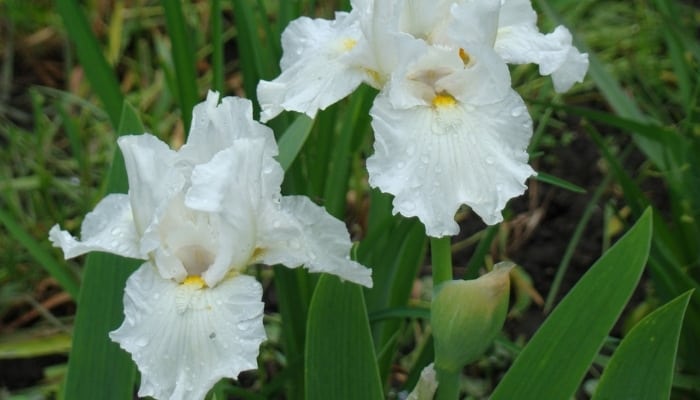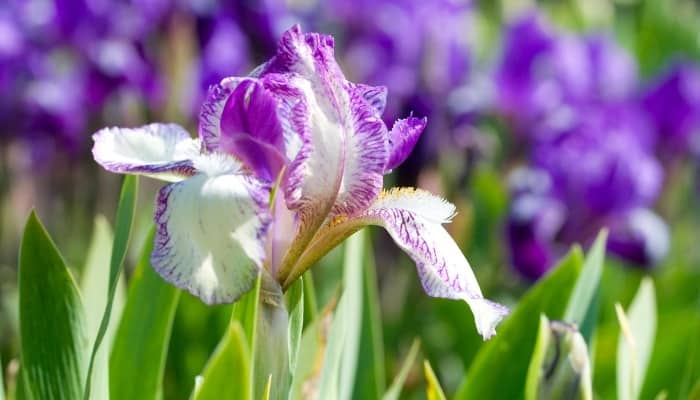The iris plant’s first line of protection is its leaves. These foliage are typically a bluish green color and have a fleshy and flexible texture when the plant is in good health.
But when something goes wrong, the leaves will wither and turn yellow. That’s your cue to investigate the real cause of the yellowing leaves and remedy any problem the plant is facing.
Why are my iris leaves turning yellow? Yellowing iris leaves can be caused by overwatering, underwatering, root rot, incorrect soil pH, too much fertilizer, lack of fertilizer, wrong type of fertilizer, lighting issues, diseases, or pests. Identifying the problem and quickly correcting it typically results in fresh, healthy new growth.
Seeing your once healthy plant start to decline can be troubling, but don’t worry.
In the following, we’ll go through all the possible causes one by one so that you can quickly identify the problem and take corrective measures.
9 Reasons for Yellow Iris Leaves (And Solutions)
As with all other plants facing adverse growing conditions, the iris goes into survival mode by conserving the nutrients and moisture at its disposal.
When the leaves don’t get enough food, they wilt and turn yellow. The reasons for this symptom vary, but they mostly fall under one or more of the following categories.
Overwatering
Overwatering the iris can have devastating effects on its rhizomes. The rhizomes are more prone to rot if they’re fully buried underground.
The plants don’t like wet or waterlogged soil. So you should allow the top soil to dry out between irrigations.
Solution
Water the iris once every 7 to 10 days depending on the weather conditions. In the peak of summer, water the plants either in the mornings or in the evenings but never at noon.
Allow the top 2 inches of soil to dry out before you water the iris.
Underwatering
Too little water has the same impact on the plant as too much water. Without water, the iris cannot support its leaves, blooms, and thriving foliage.
This causes the leaves to turn yellow before they wither and fall.
Solution
In dry weather, water the iris regularly, and don’t let the soil totally dry out. Keep in mind that the established iris doesn’t need much watering.
In the spring and summer, water the soil just enough to get it damp.
Root Rot
The rhizome of the iris is well protected with thick skin, but when that skin gets broken either by a pest or if you accidentally nip it while pruning the plant, this opens the way for bacteria such as Erwinia carotovora to enter the rhizome and cause root rot.
Solution
Root rot takes time to consume the whole rhizome of the iris. Carefully dig around the rhizome and cut any mushy or damaged parts with a sharp knife.
If less than half the rhizome is damaged, remove the old soil and replace it with fresh soil. Leave the top of the rhizome exposed, and water the plant.
Incorrect Soil pH
Like many perennials, the iris plant thrives in neutral soil. Even slightly acidic soil is good too. The problem starts when the soil acidity goes above the normal range.
If the soil is too acidic or too alkaline, you’ll need to amend it.
Solution
Acidic soil can be fixed with lime. One pound of lime reduces the acidity by a half point. As for alkaline soil, you can add sulfur. Adjust the soil pH until it’s between 6.8 to 7.0.
Overfertilization
The iris plant thrives in rich soil, but you can make up for a nutrient deficiency in the garden by adding fertilizers. However, overfertilization can have the opposite result.
Instead of promoting more growth and larger blooms, too much fertilizer can cause root rot, which leads to yellowing leaves and eventual plant death.
Solution
Apply the fertilizer twice a year. The first application should be in the spring about 6 weeks before the first flower buds have emerged. The second application should be after the last flower has faded.
Lack of Fertilization or Incorrect Type
Without the proper nutrients, the iris will not blossom and thrive. Poor soil needs to be amended with organic materials and compost.
In addition, you need to use a balanced fertilizer twice a year. The first application in the spring and the second in the late summer.
Solution
For the most part, the iris will relish a balanced 10-10-10 fertilizer (Southern Ag has an excellent product with a great reputation.
If the soil has high deposits of nitrogen, then you can switch to a 5-10-10 fertilizer.

Lighting Issues
Since they grow in full sun, a few days without sunlight during the growing season can cause the plant to wilt and the leaves to turn yellow.
It’s a sign of light deprivation that could stunt the growth of the plant and impact the blooms as well.
Solution
Make sure that your iris is growing in a spot in the garden that faces either the west or south.
This will ensure that the plant gets between 6 to 8 hours of full sun every day during the summer and spring.
Disease
Many diseases can also cause the plant to wilt. These include bacterial leaf blight, botrytis rhizome rot, crown rot, and ink spot among others.
Solution
Most of these diseases can be treated with fungicides that contain mancozeb, myclobutanil, or chlorothalonil. Read the instructions on the package carefully before applying the fungicide.
Pests
Slugs, snails, aphids, leaf bugs, and leaf-chewing caterpillars are the main pests that attack the leaves of the iris. They leave holes in the leaves which can cause them to turn yellow and drop.
Solution
Hose aphids off with a strong stream of water. Spray the iris with neem oil (I use this organic neem oil) to get rid of most of the other bugs that crawl on the leaves.
Since the plant is not edible, you can safely use chemical pesticides to kill snails and slugs.
Other Common Iris Leaf Problems
- Brown Leaf Tips: Not a serious problem unless you have borers in the rhizomes.
- Leaf Spot: A common disease where the leaves have spots. Treat it with a fungicide.
- Gray Mold: Caused by poor ventilation and high humidity levels. Space the plants well.
Related Questions:
When Do Irises Bloom?
Most types of iris bloom in the late spring or early summer. Some species such as the bearded iris will bloom again in the late summer.
When Should You Cut Back Irises?
Fall is the right time to cut back irises. Wait until the last flower has faded and the plant has stopped growing.
Conclusion
The leaves of the iris will turn yellow when the plant is not getting enough sunlight, has too much or two little water, or has been given too much or too little fertilizer.
Moderation is the key to the success of the iris plants.

